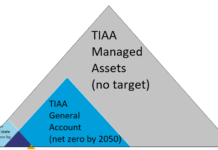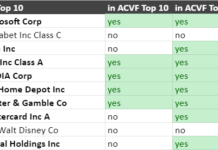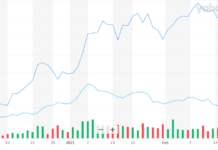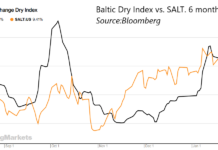Tom Konrad, Ph.D., CFA
As usual, I am putting together my Ten Clean Energy Stocks for 2020 model portfolio for publication on January 1st or 2nd next year. As I wrote in November, expensive valuations for the US clean energy income stocks I specialize in mean that the 2020 model portfolio will contain more than the usual number of foreign stocks, and I am also planning on including a little hedging with options.
Why option strategies are now affordable
I have never included options in the model portfolio before because the commission structure did not make it cost effective for small investors to trade options. That has now changed, with leading discount brokers dropping the fixed part of the commission, and now only charging $0.65 per contract, as I discussed in November. Each option contract represents the right to buy or sell 100 shares of the underlying stock or ETF, and the strategies I use typically involve options priced at $0.25 to $3 per underlying share. For a single option priced at $1, that means that the commission to enter the contract is now 0.65% of the option price ($0.65/$100) compared to the previous 5.6% ($5.60/100). If the contract is assigned, there was previously also a stock trading commission of another $4.95 (5%) commission to consider. This is now $0.
I generally consider commissions to be affordable if they are less than 5% of my expected return on a trade. I typically sell options using covered call and cash covered put strategies, meaning the expected return is on the order of half the option price. This puts the previous commissions at about 15% of the expected return for the example trade above, but the new commissions at about 1.3%. Before, I generally only traded option contracts 10 or more at a time.
The target reader of the Ten Clean Energy Stocks model portfolio is investing $20,000 or more in the portfolio, or $2000 or more in each stock. That’s just enough to buy 100 shares of a $20 stock and enter into a single option contract on the underlying position.
So, for the first time this year, I plan to use actual dollars and numbers of shares in keeping tack of the model portfolio, starting with $20,000.
Ill-liquid options
The option contracts on the stocks I typically cover are far from liquid, with the buy and ask prices typically as much as $0.50 (or $50 per contract) apart. Hence, buying at the ask price or selling at the bid is generally not a good idea. I find that a limit order placed halfway between the bid and the ask will often execute immediately. The volume of contracts traded also has very little effect on the contract price, which instead tracks the share price and volatility of the underlying stock.
Unlike stocks, options contracts can be created out of thin air. Because of this, the act of entering a limit order can create its own liquidity.
Covered call example
For example, I currently have a good-til-cancelled (GTC) limit order to sell CWEN/A June 19 2020 Calls with a strike price of $20 at limit price of $0.90. The person (or hedge fund) that buys my calls will be paying $90 per contract for the right to buy 100 shares of CWEN/A (Clearway Energy Class A shares) from me at any time before June 19, 2020.
I currently own all the shares I need of CWEN/A to cover this possible option assignment. Owning these underlying shares is what makes these contracts “covered” calls. If you are not familiar with covered calls, you can read more about it and four other hedging strategies here.
If I sell the calls at $0.90 as planned, and the contracts are not assigned (which typically happens if CWEN/A is trading at $20 or below on June 19th), I get to keep the extra $0.90 per CWEN/A share. If the option gets assigned, I sell the shares for a net $20.90 each (including the $0.90 option premium) plus any dividends earned before the calls are assigned.
The reason I say that a hedge fund is the most likely counter party for my options trade is that there are trading strategies using the underlying stock that allow someone who is long or short the options contract to completely arbitrage the risk inherent in the option position. When the price I am offering the option at (in this example) becomes higher than the hedge fund’s cost of shedding the risk inherent in the option through one of these strategies, the hedge fund will take the other side of my trade. This typically only requires a short spike in the share price because these hedge funds are using computers to constantly compare the cost of their trading strategies to the costs of options on offer.
Because these quant hedge funds will place trades to create new options contracts whenever the price is right, the effective liquidity of options contracts is much higher than it appears from the volume of actual trading.
Put another way, do not let the typical wide spreads you see between option bid and ask prices deter you from trading them. Just decide the price at which you are willing to trade, and place a good-til-cancelled limit order at that price.
In the above example, I am willing to sell a few hundred shares of CWEN/A at $20.90, so $0.90 is the option premium I am asking in my limit order.
Foreign stocks
In many cases, trading foreign stocks on the US markets is similar to trading options. For this example, we will use Valeo SA (FR.PA, VLEEF, VLEEY.) Note that Valeo has three ticker symbols. FR.PA means that the company’s primary listing is in Paris (the .PA part) and it trades with the ticker “FR.” An alternative convention for denoting the same thing would be “Paris:FR.” Similarly, CWEN/A above could also be written NYSE:CWEN/A since the stock trades on the New York Stock Exchange. I usually omit the “NYSE:”, “NASD:” and “OTC:” from US listings, since you do not need this information to trade the stock.
In addition to their home markets, foreign stocks may trade in the US as an American Depository Receipt, or ADR. ADR’s can be listed on US exchanges (for example, Mix Telematics (NYSE:MIXT) or just MIXT). More often, they trade on the over the counter market, in which case they have a five character ticker ending in “Y” like VLEEY. ADRs are created by banks which purchase shares of the underlying stock on the foreign market, and then sell ADRs representing some number of those shares to US investors. VLEEY represents half a share of FR.PA, while MIXT represents 25 ordinary shares of Johannesburg:MIX or MIX.SJ on the South African Johannesburg Stock Exchange.
The sponsoring banks charge a small fee for creating ADRs which is deducted from stock dividends when they are paid.
Some brokers also allow clients to directly purchase foreign stocks using a five letter ticker ending in “F” such as VLEEF. In this case, the broker either directly trades on the foreign exchange on behalf of the client, or does so through an affiliate. Trading commissions are typically much higher for trades of the foreign stock (VLEEF) than they are for the ADR VLEEY, but trading the foreign stock directly may be more cost effective for larger trades when the investor plans to hold the stock for a long time because trading VLEEF avoids the ADR fee. Investors may also ask that shares of the ADR be converted to foreign shares for a one-time fee.
I typically try to trade the foreign shares in large blocks rather than pay the ADR fee, but most investors will likely find that using the ADRs is more economical.
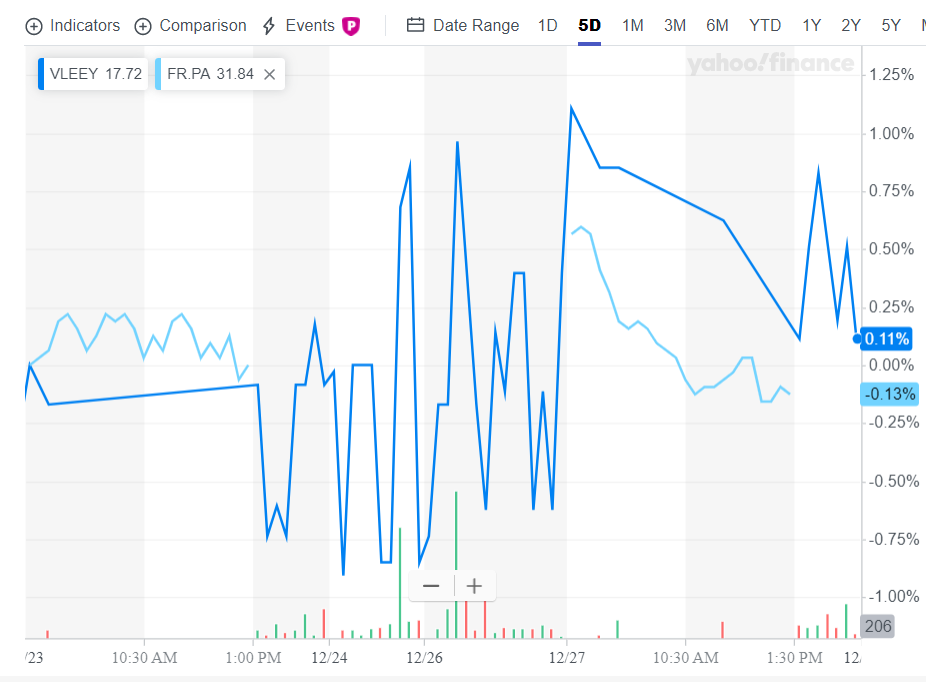
How trading foreign stocks is like trading options
As with options, the number of shares of foreign stocks or ADRs available has more to do with the liquidity of the stock on its home exchange than the number of shares which are traded in the US. When placing an order for a relatively illiquid ADR like VLEEY (approximately 12,000 shares traded per day), it is best look at the stock chart of FR.PA in Euros (you can find it on Yahoo! Finance here, choose a limit price based on that and your own fundamental calculations, and then convert it to an ADR or foreign stock price for VLEEY or VLEEF before placing a limit order with your broker.
For example, if I decide I want to buy Valeo for €32, I would multiply by the Euro/$ exchange rate (currently €1.1181/$) and the ADR multiplier (if any) to place a limit order for VLEEF at $35.78 or VLEEY at $17.89. Note that trades of VLEEF can happen whenever the Paris stock market is open, but trades of VLEEY will take place when the US market is open.
Conclusion
Investors should not let the apparent low liquidity for exchange traded options or foreign stocks and ADRs on US markets deter than from trading either. As long as you are careful to use limit orders at a price at which you are happy to trade, the worst thing that can happen is that you end up not trading at all.
Disclosure: Long CWEN/A, MIXT, VLEEF.



